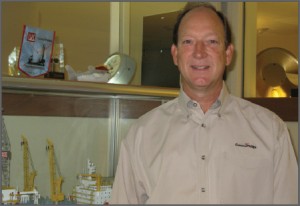Perspectives: Brett Borland, ConocoPhillips Building a career on technology innovations
By Linda Hsieh, managing editor

Being in the right place at the right time can make or break a career, depending on whether you can rise up to the challenge. For Brett Borland, who in 1980 was just a fresh graduate from Louisiana State University with a mechanical engineering degree who had never seen a drilling rig before in his life, he is one who rose to the challenge. He is now manager drilling planning & operations in the global wells organization for ConocoPhillips.
His first opportunity came in 1980, when Sedco sent him to a North Sea rig as a roustabout. While none of his crew mates wanted to be a roughneck because they didn’t want to do the work, he volunteered himself – even though he had been working as a roustabout for a mere five days.
Just four months later, Mr Borland again stepped up when the company was looking to fill an empty derrickman position. “People tend to wait and hope that somebody’s going to come along and lead them by the hand and guide their career. I think you need to take a more proactive role,” he said.
Within nine months of his initial job interview with Sedco, Mr Borland had been promoted to assistant driller on the Sedneth 701, drilling for Phillips Petroleum on the North Sea’s Maureen field. “Because it was a template and we were drilling very fast, the company was bringing out new technologies to us all the time to try,” he recalled. These included some of the industry’s first MWDs and automated pipe-handling tools. “Some of them worked, some of them didn’t. It was a bit of a proving ground for new tools,” he said.
Perhaps his experience on this “proving ground” shaped him into an early adopter of technology: Through his career, Mr Borland has time and again put himself in places where new and emerging technology innovations were applied and proven, from the industry’s first top drives to horizontal drilling to managed pressure drilling to casing drilling.
In the early ’80s, Mr Borland went to Abu Dhabi to work on the brand-new Sedneth 202 jackup, where the first top drives were being used in the industry in commercial applications. Because of this experience, he eventually ended up working for Varco, helping the company install the first top drives in the Gulf of Mexico. “There were three that were put in initially, and I was on the installation of all three of them,” he said.
In 1984, Mr Borland joined Houston-based Sun Exploration & Production, where he was part of a team that drilled a very early offshore well using managed pressure drilling. “It was around 1986 off the Henry Platform in the Santa Barbara Channel. We drilled two wells using air to lighten the mud hydrostatic, and the production was significantly better than we anticipated. It wasn’t until later that I realized the elimination of skin damage had improved production,” he recalled.
In the late ’80s, he moved onshore and worked on the industry’s first horizontal wells in the Austin Chalk. “Horizontal wells had been drilled before, but they didn’t target the reservoir to stay horizontal. I was on the first exploratory wells doing horizontal, and we found some fantastic surprises down there. Those wells made a lot more than we ever anticipated.”
By 1990, Mr Borland had joined Conoco, and he found himself again working on industry-first technology, particularly for deepwater. From 1996 to 1999, Mr Borland was part of the Deepwater Pathfinder drillship design and construction team. This drillship was one of the first in the new generation of rigs that could operate in 10,000 ft of water in the Gulf of Mexico. He is proud of the fact that this vessel and its sister ship, the Deepwater Frontier, were delivered on time and on budget.
These vessels also had the first active heave compensating drawworks and incorporated cyber-based drill floor control systems, along with extensive use of variable frequency drives in first-time drilling system applications. Mr Borland and his team members received an Engineering Excellence Award from DuPont for this project in May 1999.
Since then, he’s also worked on innovative applications of casing drilling: The industry’s first offshore directional drilling-with-casing well was completed about five years ago on Norway’s Elkfisk Platform. “Casing drilling has become a standard practice for us over there now,” he said.
Mr Borland believes that, although the bar has been raised in terms of technology applications in today’s high-cost market, industry must push ahead with innovation. “In some places you can’t get the well down without enabling tools like managed pressure drilling or casing drilling. We need to continue developing more tools for the toolkit so we can pull them out when we need them.”




